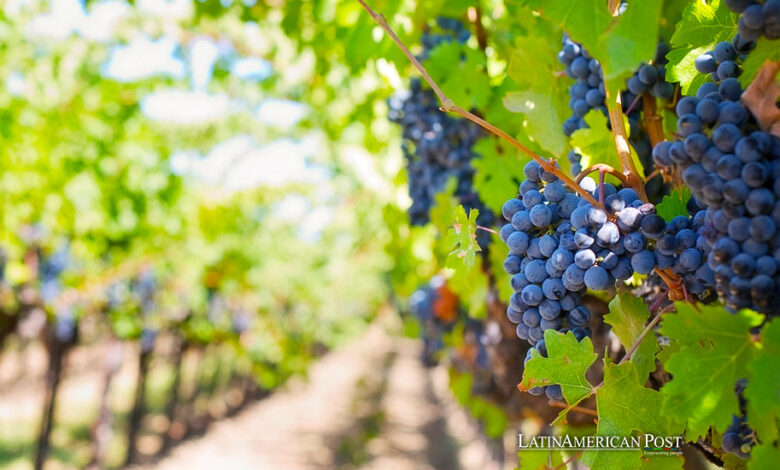Chilean Vineyards: Blending Tradition and Innovation in Winemaking

In the fertile valleys of Chile, ancient winemaking traditions meet cutting-edge technology, crafting wines that captivate palates worldwide. This feature explores how Chile’s vineyards lead a global revolution, seamlessly integrating time-honored methods with modern innovations to produce world-renowned wines.
Chile has become a significant player in the global wine industry, captivating international audiences with its distinctive and high-quality wines. This success can be attributed to two key factors: a rich winemaking heritage dating back centuries and a relentless pursuit of innovation that embraces modern technology. Chile’s unique geographical and climatic conditions, with its long, narrow coastline influenced by the Humboldt Current and the imposing presence of the Andes Mountains, further contribute to its exceptional viticulture potential.
Historical Context
The roots of Chilean winemaking can be traced back to the Spanish conquest in the 16th century. Missionaries introduced European grape varietals like Pais and Muscat, laying the foundation for the industry. The 19th century saw a surge in wine production, with French grape varietals like Cabernet Sauvignon and Carmenere gaining prominence. However, in the late 20th century, Chile emerged as a force to be reckoned with in the global wine market. This period witnessed significant technological advancements, vineyard management, and a renewed focus on quality and innovation.
The Terroir of Chile
Chile boasts diverse terroirs, each contributing distinct characteristics to the resulting wines. The Central Valley, encompassing regions like Aconcagua and Colchagua, is renowned for its warm Mediterranean climate, producing bold and full-bodied reds. Moving north, the Atacama Desert influences the Elqui Valley, which is known for its crisp white wines and refreshing Sauvignon Blancs. The cool coastal influences of the Pacific Ocean shape the Casablanca Valley, which is known for its elegant Pinot Noirs and Chardonnay. Further south, the Maule Valley offers a broader range of varietals, while the cool climate and volcanic soils of Bio-Bio foster unique expressions of Pinot Noir and Riesling. Finally, in the southernmost reaches of Patagonia, the Limarí Valley emerges as a rising star with its expressive Sauvignon Blancs and cool-climate Syrahs.
Tradition Meets Technology
Chilean vineyards pay homage to their heritage by preserving traditional winemaking practices. Hand-picking grapes, meticulous attention to detail in the cellar, and a focus on minimal intervention are hallmarks of Chilean winemaking. However, these traditions are not set in stone. Modern technology plays a crucial role in enhancing these time-tested methods. Using data analysis and advanced weather monitoring, precision viticulture allows for targeted vineyard management and optimal grape quality. Additionally, fermentation techniques and temperature control advancements ensure consistent quality and expression of the unique terroir.
Spotlight on Sustainability
Sustainability is becoming an increasingly important aspect of Chilean winemaking. Many vineyards are adopting organic and biodynamic practices to minimize their environmental impact. While requiring more labor and meticulous attention, these practices result in healthier soils, increased biodiversity, and, ultimately, wines that are a purer expression of the land. Additionally, water conservation initiatives and energy-efficient practices are being embraced to reduce the environmental footprint of the industry further.
Iconic Chilean Wines
Chile boasts a portfolio of internationally acclaimed wines and varietals. Carmenere, a grape rediscovered in Chile after being mistaken for Merlot for decades, has become a national signature red known for its spicy and plummy character. Cabernet Sauvignon thrives in the warm climate of the Central Valley, producing bold and structured wines with notes of blackcurrant and cassis. Syrah, finding a perfect home in the cool-climate regions, offers elegant expressions with peppery and smoky notes. Chardonnay and Sauvignon Blanc, particularly from Casablanca Valley, exhibit freshness and minerality, reflecting the coastal influences. Winemakers in Chile emphasize the importance of showcasing the unique terroir in each bottle, resulting in wines that are distinctive and representative of their origin.
The People Behind the Wine
Chile’s wine industry is driven by passionate individuals who dedicate their lives to crafting exceptional wines. Pioneers like Miguel Torres from Concha y Toro and Marcio Rubio from Santa Rita are recognized for their contributions to establishing Chile’s reputation in the global market. Today, a new generation of innovative winemakers, like Isabel Mitarakis of Unrated, is pushing boundaries and experimenting with unconventional techniques, pushing the envelope of what Chilean wine can be.
Challenges and Opportunities
The Chilean wine industry faces several challenges, including climate change, increasing competition from other wine-producing countries, and evolving consumer preferences. However, these challenges also present opportunities for innovation and growth. The industry is actively adopting sustainable practices to mitigate the impact of climate change. Additionally, exploring new regions with unique terroirs and focusing on niche, high-quality wines cater to evolving consumer demands.
Looking to the Future
The future of Chilean winemaking is brimming with possibilities. Biodynamic practices, which emphasize the holistic relationship between the environment, the vines, and the wine, are gaining traction and offering exciting new expressions. Exploration of new, cool-climate regions with promising potential for Pinot Noir and Chardonnay is expanding the diversity of Chilean wines. Additionally, the role of technology will continue to evolve, with advancements in areas like precision fermentation and artificial intelligence shaping the future of winemaking.
However, navigating this future requires striking a balance between tradition and innovation. While embracing cutting-edge technology can elevate quality and efficiency, it is crucial to maintain the distinct character and quality that have made Chilean wines renowned worldwide. Preserving traditional practices and safeguarding the unique territories of Chile is paramount to ensuring the continued success and identity of the industry.
Also read: U.S. Eyes Chilean Lithium to Power Electric Future: A Strategic Partnership Emerges
Chilean vineyards have established themselves as a force to be reckoned with in the global wine industry. Their unwavering commitment to excellence, characterized by the seamless blend of tradition and innovation, has resulted in captivating wines that captivate palates worldwide. From the Central Valley’s sun-drenched valleys to Casablanca’s excellent coastal slopes, Chilean winemakers continue to write their story, one sip at a time. As the industry evolves, embracing new opportunities while staying true to its roots, Chilean wines are poised to continue captivating the world with their distinctive character and unwavering quality. They remain a symbol of Chilean craftsmanship and cultural heritage for generations.





